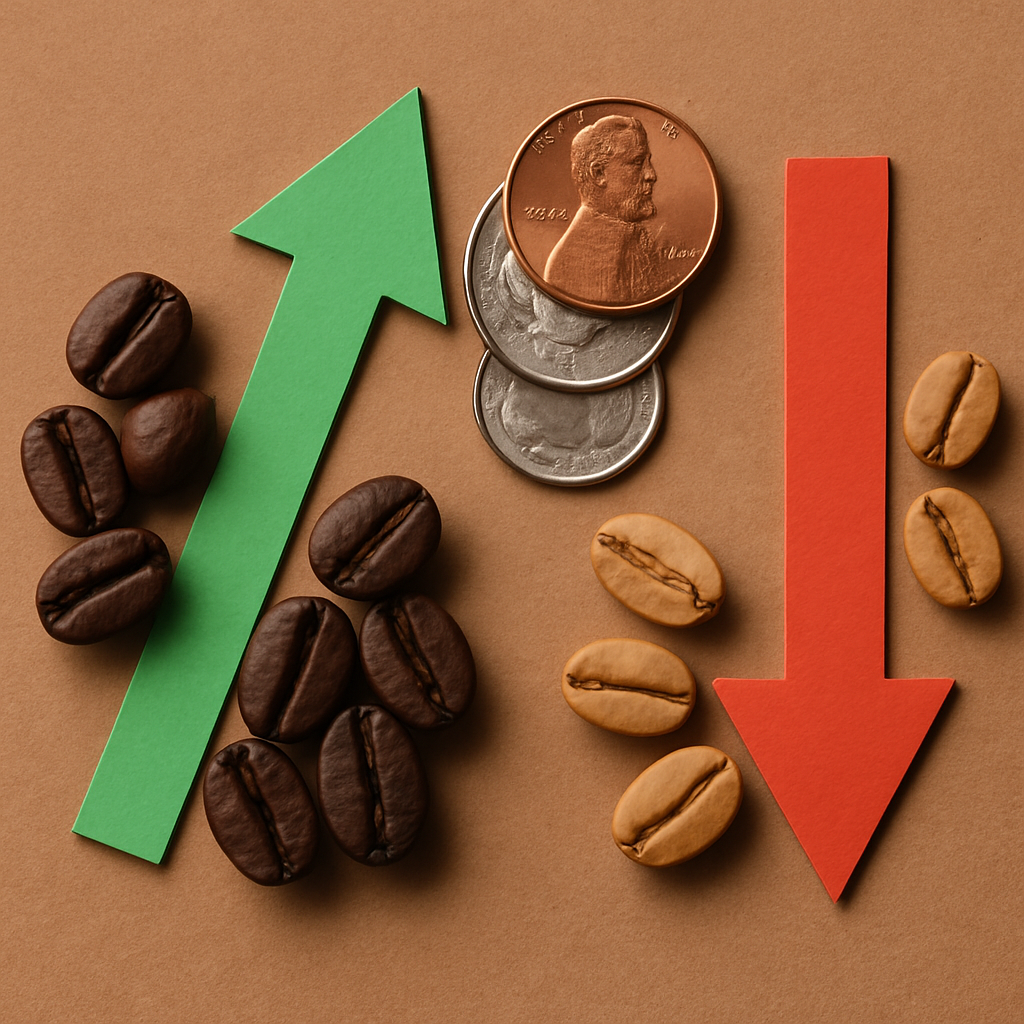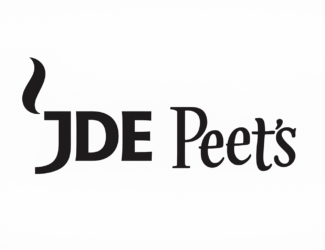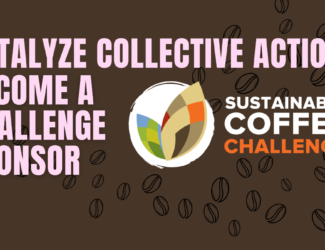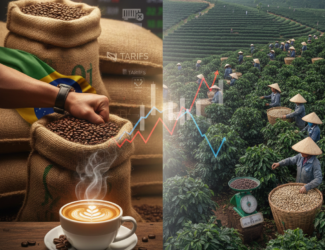
Coffee Prices Mixed as Robusta Surges and Arabica Faces U.S. Tariff Pressure
Dubai – Qahwa World
Coffee futures ended Monday in mixed territory as robusta prices climbed on concerns over heavy rains in Vietnam, while arabica remained under pressure from uncertainty surrounding U.S. tariff policy and ongoing harvest progress in Brazil. December arabica (KCZ25) fluctuated during the session and ultimately closed down -1.50 (-0.41%), while November robusta (RMX25) gained +121 (+2.93%).
The sharp rise in robusta was fueled by forecasts of heavy rainfall across Vietnam’s Central Highlands, the country’s key growing area, which could damage cherries entering their final stage of development before harvest. Vietnam, the world’s largest producer of robusta, continues to play a decisive role in global market movements. Despite the short-term weather risks, the country is still expected to deliver a bumper crop, with 2025/26 production projected to climb 6% year-on-year to 1.76 million metric tons, or 29.4 million bags, the highest level in four years. Export momentum remains strong as well, with shipments from January to August up 7.8% compared with the previous year, reaching 1.141 million metric tons.
Arabica, meanwhile, faced renewed selling pressure linked to the policy debate in Washington, where lawmakers are considering a bill that would exempt coffee imports from tariffs. The United States currently maintains a 50% tariff on Brazilian imports, a measure that has disrupted traditional trade flows and forced buyers to cancel contracts. This has tightened U.S. supplies significantly, with ICE-monitored arabica inventories falling to a 17-month low of 643,341 bags. Robusta inventories also dropped to a 1.75-month low of 6,464 lots. The trade impact is considerable, since Brazil accounts for roughly one-third of America’s unroasted coffee imports.
While tariffs weigh on demand for arabica, supply-side pressures in Brazil are offering a degree of support. Somar Meteorologia reported that Minas Gerais, Brazil’s largest arabica-producing state, received only 10.5 millimeters of rain during the week ending September 20, representing just 73% of the historical average. September is a critical flowering month for coffee trees, and any shortage of rain could compromise the next crop cycle. Earlier this month, Brazil’s crop agency Conab cut its forecast for the 2025 arabica harvest by 4.9% to 35.2 million bags and lowered total coffee production to 55.2 million bags, reinforcing concerns about supply.
Globally, the balance remains tight despite expectations of record output. The USDA’s Foreign Agriculture Service projects that world coffee production will increase by 2.5% in 2025/26 to reach 178.68 million bags. Arabica output, however, is forecast to decline 1.7% to 97 million bags, while robusta is expected to rise by nearly 8% to 81.6 million bags. This uneven growth underlines the structural imbalance in the market. Commodity trader Volcafe has warned that the arabica deficit will widen to 8.5 million bags in 2025/26, compared with 5.5 million bags in the previous cycle, marking the fifth consecutive year of shortfalls.
Export figures add further weight to bullish sentiment. The International Coffee Organization reported earlier this month that global shipments in July fell 1.6% year-on-year to 11.6 million bags, while cumulative exports for the first ten months of the current season declined 0.3%. Brazil’s shipments saw particularly sharp declines. Data from the Trade Ministry showed that unroasted coffee exports in July plunged 20.4% to 161,000 metric tons, while exporter group Cecafe reported green coffee shipments down 28% to 2.4 million bags. Robusta exports collapsed by nearly half. In total, Brazil’s shipments between January and July dropped 21% to 22.2 million bags.
In the short term, harvest pressure continues to weigh on arabica prices. Brazil’s Cooxupe cooperative, the country’s largest exporter group, reported that its members had completed 98.9% of the harvest by September 12, signaling that near-term supply remains ample. Yet market participants remain cautious about the months ahead, with the National Oceanic and Atmospheric Administration forecasting a 71% chance of La Niña developing between October and December. Such a weather pattern could intensify drought conditions in Brazil and place the 2026/27 crop at risk.
The global coffee market thus finds itself pulled in opposite directions. On one side, robusta prices are supported by immediate weather risks in Vietnam, while arabica is weighed down by trade policy uncertainty and harvest dynamics in Brazil. On the other, tightening inventories, shrinking exports, and the prospect of continued arabica deficits provide a strong bullish undertone. With weather volatility and geopolitical trade policies both in play, analysts expect price swings to remain a defining feature of the market for months to come.



